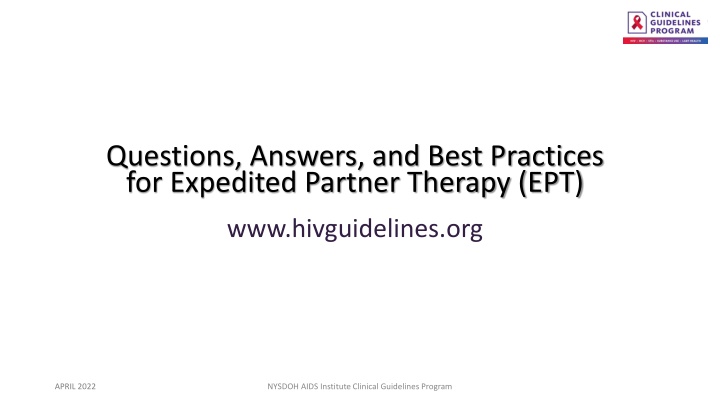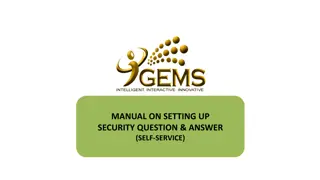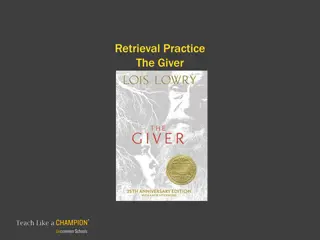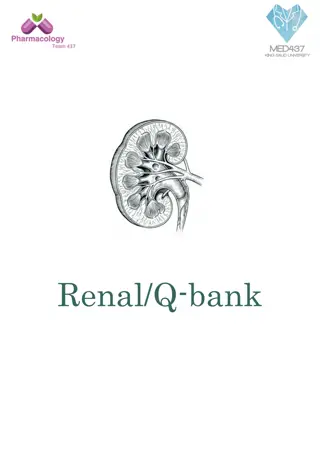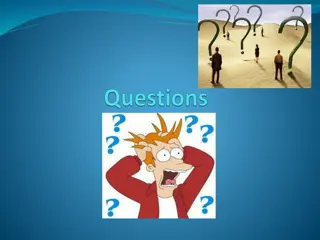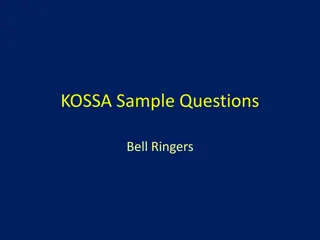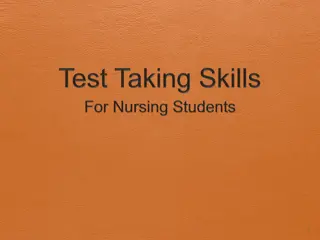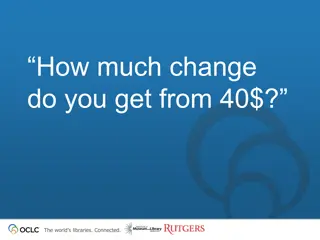Questions, Answers, and Best Practices
Expedited Partner Therapy (EPT) is crucial for the prompt treatment of STIs in sex partners, reducing morbidity and mortality risks. This guidance informs clinicians on the regulations, legal aspects, and eligibility criteria related to EPT, emphasizing its role in enhancing public health outcomes and accessibility to essential services. Understanding EPT's significance, implementation, and legal framework is essential for healthcare providers to effectively utilize this strategy in combating sexually transmitted infections.
Download Presentation

Please find below an Image/Link to download the presentation.
The content on the website is provided AS IS for your information and personal use only. It may not be sold, licensed, or shared on other websites without obtaining consent from the author.If you encounter any issues during the download, it is possible that the publisher has removed the file from their server.
You are allowed to download the files provided on this website for personal or commercial use, subject to the condition that they are used lawfully. All files are the property of their respective owners.
The content on the website is provided AS IS for your information and personal use only. It may not be sold, licensed, or shared on other websites without obtaining consent from the author.
E N D
Presentation Transcript
Questions, Answers, and Best Practices for Expedited Partner Therapy (EPT) www.hivguidelines.org APRIL 2022 NYSDOH AIDS Institute Clinical Guidelines Program
Why is EPT Important Why is EPT Important The purpose of this guidance is to inform clinicians about existing regulations that allow expedited treatment of sex partners of individuals diagnosed with gonorrhea, chlamydia, or trichomoniasis. STIs are a significant cause of morbidity and mortality and may result in infertility, chronic abdominal pain, and an increased risk of acquiring HIV. NYS ranks 17th and 19th among all states for total number of cases of chlamydia and gonorrhea, respectively. EPT is an essential health service designed to be low barrier. NYS encourages care providers to take steps to make EPT as available as possible. APRIL 2022 NYSDOH AIDS Institute Clinical Guidelines Program www.hivguidelines.org
What is EPT? What is EPT? Expedited partner therapy, or EPT, is the clinical practice of providing prescription medication for STI treatment without a healthcare visit for the sex partners of patients with newly diagnosed chlamydia, gonorrhea, or trichomoniasis. EPT is an opportunity to lower the threshold to an essential sexual health service and make treatment broadly available. EPT is not intended to replace clinic visits but to provide an alternative strategy for treating partners who are unable or unwilling to see a care provider for treatment. Clinic visits provide opportunities for STI screening, risk-reduction counseling, and HIV PrEP. APRIL 2022 NYSDOH AIDS Institute Clinical Guidelines Program www.hivguidelines.org
Is EPT Legal, and Who Is Eligible? Is EPT Legal, and Who Is Eligible? Yes, in NYS, EPT is explicitly legal under NYS Public Health Law 2312 and can be provided for treatment of chlamydia, gonorrhea, and trichomoniasis, as recommended by the 2021 CDC STI Treatment Guidelines. EPT is permissible or potentially allowable in 50 states. State laws determine the STIs covered, who can receive EPT, and how it can be provided. Clinicians should review state-specific guidance before providing EPT. Sex partners of patients with a clinical or laboratory diagnosis of gonorrhea, chlamydia, and trichomoniasis (referred to as index patients) are eligible for EPT, which can be prescribed regardless of the sexual or gender identity of the index patient or their sex partner. There is no age threshold for EPT in NYS. According to NYS Public Health Law 2305, individuals <18 years old may give effective informed consent for services related to screening, treatment, and prevention of STIs. APRIL 2022 NYSDOH AIDS Institute Clinical Guidelines Program www.hivguidelines.org
Eligibility for Expedited Partner Therapy Eligibility for Expedited Partner Therapy Eligible for EPT Patients with a clinical (without laboratory confirmation) or laboratory diagnosis of chlamydia, gonorrhea, or trichomoniasis (referred to as index patients) and their sex partners All sex partners exposed within 60 days before the index patient s symptom onset or diagnosis The most recent sex partner, if the index patient has had no sex partners within 60 days of the diagnosis Not Eligible for EPT Patients known to have syphilis in addition to gonorrhea, chlamydia, or trichomoniasis Cases involving suspected or confirmed abuse (i.e., child abuse, sexual assault, or sexual abuse) Note: Per NYS law, individuals <18 years old may give effective informed consent for services related to screening, treatment, and prevention of STIs. APRIL 2022 NYSDOH AIDS Institute Clinical Guidelines Program www.hivguidelines.org
What About Patients With Syphilis? What About Patients With Syphilis? The recommended management of partners of individuals diagnosed with syphilis varies significantly depending on the stage of syphilis in the index patient. No data support use of EPT to treat partners of patients with syphilis. Partner services offered through state or local health departments are available to assist with partner treatment for syphilis throughout NYS. A clinician may prescribe EPT for gonorrhea, chlamydia, or trichomonas to a patient while syphilis test results are pending or if they are unable to be tested (e.g., a symptomatic telehealth visit). APRIL 2022 NYSDOH AIDS Institute Clinical Guidelines Program www.hivguidelines.org
Preferred and Alternative Regimens for Preferred and Alternative Regimens for Expedited Partner Therapy Expedited Partner Therapy STI Preferred EPT Regimen Alternative EPT Regimen Comments Doxycycline and levofloxacin are contraindicated in pregnancy Azithromycin is recommended for treatment of chlamydia in patients with unknown pregnancy status Chlamydia Doxycycline 100 mg by mouth twice daily for 7 days OR azithromycin 1 g by mouth in a single dose Levofloxacin 500 mg by mouth daily for 7 days Gonorrhea Cefixime 800 mg by mouth in a single dose -- Treat for chlamydia if it has not been excluded Trichomoniasis Metronidazole 2 g by mouth in a single dose OR tinidazole 2 g by mouth in a single dose Metronidazole 500 mg by mouth twice daily for 7 days Counsel symptomatic pregnant patients with trichomoniasis regarding the potential risks and benefits of treatment Note: EPT treatment for an index patient and their sex partner(s) may not be the same. APRIL 2022 NYSDOH AIDS Institute Clinical Guidelines Program www.hivguidelines.org
Prescribing EPT Prescribing EPT Clinicians may dispense EPT medications in person at the point of care or may provide a prescription for the medications. Partner packs, dispensed in person, are preferred. Partner packs include medication for the index patient and the sex partner along with informational materials. When partner packs are not available, clinicians can provide a prescription to the index patient for their partner, along with informational materials and clinic contact information. If providing a prescription for EPT, the prescription must have EPT in the comments below the care provider information and above the medication, the dosage, refills (0), and instructions for use. The prescription may be issued electronically or on an official NYS prescription form. NYS Law: Medications must be labeled with the name and address of the dispenser, directions for use, date of delivery, the proprietary or brand name of the drug, and the strength of the contents. APRIL 2022 NYSDOH AIDS Institute Clinical Guidelines Program www.hivguidelines.org
Educating Patients About EPT Educating Patients About EPT Advise index patients to inform their sex partner(s) that they may have been exposed to an STI (chlamydia, gonorrhea, or trichomoniasis) and should seek evaluation and treatment even if they do not have symptoms. Emphasize that partners should read the information provided before they take the EPT medication. Make clear that the partner should seek medical care before starting the EPT medication if they: Are allergic to antibiotics Have abdominal pain, pelvic pain, testicular pain, fever, nausea, vomiting, or other symptoms of serious illness that require evaluation and may require treatment beyond EPT Are pregnant or could be pregnant Have serious health problems Are taking prescription or nonprescription drugs, because potentially dangerous drug-drug interactions could occur APRIL 2022 NYSDOH AIDS Institute Clinical Guidelines Program www.hivguidelines.org
Educating Patients About EPT, Educating Patients About EPT, continued continued Educate index patients and partners about: The possibility that additional treatment may be needed if the patient or partner has an STI that is not covered by the delivered EPT Abstaining from sexual activity for at least 7 days after treatment is ended to decrease the likelihood of reinfection Prevention of STIs in the future, including the use of barrier protection and PrEP for prevention of HIV The preferred approach to STI care for partners, which is to see a health care provider for a complete STI evaluation, including HIV testing, even if they take the EPT medications Where can I find free educational materials? NYS offers free educational materials for distribution to partners: https://www.health.ny.gov/diseases/communicable/std/ept/index.htm APRIL 2022 NYSDOH AIDS Institute Clinical Guidelines Program www.hivguidelines.org
Payment and Follow Payment and Follow- -Up for EPT Up for EPT Medication costs are the responsibility of the sex partner and may be paid for in cash or through health insurance coverage. The index patient s insurance cannot be billed for medications for a partner. If an index patient s partner is uninsured, then the best approach is to provide the EPT medications in person when available. Contact the index patient and, with consent, their partner by phone to ensure they have or will pick up the medications and that symptoms resolve. Schedule follow-up visits for index patients if symptoms persist or at 3 months for repeat testing because of the risk of reinfection. Advise that sex partners follow up for comprehensive sexual health services as soon as they are able. APRIL 2022 NYSDOH AIDS Institute Clinical Guidelines Program www.hivguidelines.org
Best Practice Reminders for EPT Best Practice Reminders for EPT The best practice for STI care is to see and evaluate the sex partner(s) of an index patient diagnosed with an STI. An index patient may, if asked, be able to bring their sex partner(s) with them when they come for treatment. EPT is a legal alternative STI treatment strategy for sex partners of patients with a clinical or laboratory diagnosis of gonorrhea, chlamydia, or trichomonas (not syphilis) and who are not able or not willing to be seen for medical care. When possible, EPT should be provided as a partner pack that includes medication, informational materials, and clinic contact options. When a partner pack is not available, a clinician can provide the index patient with a prescription for their partner(s) along with informational materials and clinic contact options. APRIL 2022 NYSDOH AIDS Institute Clinical Guidelines Program www.hivguidelines.org
Best Practice Reminders for EPT, Best Practice Reminders for EPT, continued continued If a prescription for EPT is provided instead of a partner pack, the partner is responsible for the cost of the medications. Azithromycin is the EPT option for treatment of chlamydia in a partner who is or could be pregnant. Follow up by phone with the index patient to ensure that they have their medications or will be able to get them, and if appropriate, to ask if symptoms have resolved. With consent, also follow up with the partner(s) who received EPT. APRIL 2022 NYSDOH AIDS Institute Clinical Guidelines Program www.hivguidelines.org
Need Help? Need Help? NYSDOH AIDS Institute Clinical Guidelines Program www.hivguidelines.org
Access the Guidance Access the Guidance www.hivguidelines.org > Questions, Answers, and Best Practices for Expedited Partner Therapy (EPT) Also available: Printable pocket guide and PDF NYSDOH AIDS Institute Clinical Guidelines Program www.hivguidelines.org
